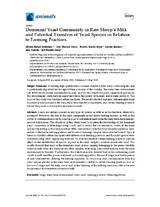Mostrar el registro sencillo del ítem
Dominant Yeast Community in Raw Sheep’s Milk and Potential Transfers of Yeast Species in Relation to Farming Practices
| dc.contributor.author | Quintana, Álvaro Rafael | |
| dc.contributor.author | Perea Muñoz, José Manuel | |
| dc.contributor.author | García-Béjar, Beatriz | |
| dc.contributor.author | Jiménez, Lorena | |
| dc.contributor.author | Garzón Sigler, A. | |
| dc.contributor.author | Arias, Ramón | |
| dc.date.accessioned | 2020-05-22T19:28:15Z | |
| dc.date.available | 2020-05-22T19:28:15Z | |
| dc.date.issued | 2020 | |
| dc.identifier.uri | http://hdl.handle.net/10396/19969 | |
| dc.description.abstract | Yeasts are always present in any type of cheese, as well as in the factories where it is produced. However, the role of the yeast community in the cheese making process, as well as the routes of contamination used by yeast species to contaminate milk from the dairy farm environment, are not well known. The objectives of this study were to broaden the knowledge of the dominant yeast community in Manchega sheep’s milk and to assess the contamination routes of the yeast species depending on the farm practices. Milk, teat surface (collected from ten ewes per farm), feed, and air (collected in milking parlours and livestock housing) samples were collected from 12 typical farms in Castilla-La Mancha, Spain with differences in farming practices, and the yeast species were identified using DNA sequencing methods. To evaluate whether certain farming practices have an effect on the distribution of species of yeast in the milk samples, a mixed model was used. The results showed that most of the dominant yeast species (mainly belonging to the genus Candida) found in milk were also found in the other samples, indicating a microbial transfer from the farm environment to the milk. Furthermore, the statistical model showed that factors influencing yeast counts in milk were the presence of yeasts in the milking parlour, the use of silage, and the frequency of acid treatment for cleaning the milking machines. In conclusion, milk contamination from the yeast species present in the dairy farm environment is related to certain farming practices such as the use of silage and the daily use of acid in the cleaning of the milking machines, which favours the presence of desirable microbiota in milk. | es_ES |
| dc.format.mimetype | application/pdf | es_ES |
| dc.language.iso | eng | es_ES |
| dc.publisher | MDPI | es_ES |
| dc.rights | https://creativecommons.org/licenses/by/4.0/ | es_ES |
| dc.source | Animals 10(5), 906 (2020) | es_ES |
| dc.subject | Fungi | es_ES |
| dc.subject | Dairy farm environment | es_ES |
| dc.subject | Ewe’s milk | es_ES |
| dc.subject | Farming practices | es_ES |
| dc.subject | Manchega breed | es_ES |
| dc.title | Dominant Yeast Community in Raw Sheep’s Milk and Potential Transfers of Yeast Species in Relation to Farming Practices | es_ES |
| dc.type | info:eu-repo/semantics/article | es_ES |
| dc.relation.publisherversion | http://dx.doi.org/10.3390/ani10050906 | es_ES |
| dc.relation.projectID | Gobierno de España. RTA2011‐00057‐C02‐01 | es_ES |
| dc.rights.accessRights | info:eu-repo/semantics/openAccess | es_ES |

